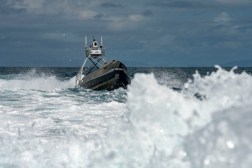Over-the-air updates now ‘matter of course’ through Project Overmatch

SAN DIEGO, Calif. — The Navy is able to deliver over-the-air software and capability updates to ships through its secretive effort known as Project Overmatch.
While there have been experiments and technologies that the Navy has been using for years to demonstrate these types of updates, frequent deliveries only came about fairly recently.
“We did demos years ago where we were able to show them certainly it’s possible. But in terms of doing it as a matter of course, that’s come in the last probably a year-and-a-half or so,” Rear Adm. Douglas Small, commander of Naval Information Warfare Systems Command, said Wednesday at the annual WEST conference, adding that ships can be in port or be connected via a satellite link to receive updates.
“We made tremendous headway. The ability to deliver updates, software over the air — you can imagine the amount of change that had to go on from the entire value chain and how you deliver capability. There’s been a lot of really good work on that. Still more to go,” he said.
Small leads the Navy’s tight-lipped Project Overmatch effort, which seeks to connect the fleet and enable forces to operate in a distributed manner. That endeavor falls in line with the Pentagon’s number one priority to connect networks, data, platforms, sensors and shooters across the joint forces in order to make faster and more informed decisions than adversaries. The concept is known as Joint All-Domian Command and Control (JADC2).
Project Overmatch is a key initiative for Chief of Naval Operations Adm. Lisa Franchetti, who sees it as an opportunity to gain advantages and think differently about how to integrate disruptive and emerging technologies to adapt to changes in warfare.
“Through Project Overmatch, we’re building a software-defined network solution and modern software pipelines to provide as many pathways as is possible to connect and share information. This initiative is an effort to transmit any data over any network and is the connective tissue between today’s fleet and tomorrow’s emerging hybrid fleet,” she said Tuesday at the conference. “In using that connectivity, we’re working to evolve Aegis and the ship self-defense system into a single, hardware-agnostic software suite, like the integrated combat system, that all ships can pull from to conduct missions alone or in a group. This system will enable a surface action group, a strike group and a fleet, or any combination of integrated combat system-equipped ships to operate as a single, seamless system and become a true system of systems.”
Carrier Strike Group 1 and its flagship, the USS Carl Vinson, was one of the first to begin receiving Overmatch capabilities last year, serving as a test bed to experiment with accelerating the scaling of these technologies.
Since then, the Navy has equipped additional strike groups with Overmatch capabilities.
“We did a lot of testing on fielding of systems on Vinson. Vinson is deployed with our capabilities. We certainly have moved on and fielded out additional strike groups. It’s never something that we’re done with. It’s a constant learning and a constant improving process,” Small said. “What’s neat about the way we’re delivering our tools, software and things is that we can take in direct feedback and make the updates in stride with the fleet. Not only have we fielded, we’ve updated and re-fielded and delivered — over the air — capabilities based on what it is that the sailors need. It’s a constant learning, growing, getting better, updating our own systems, updating our own pipelines for how we field, how we do cybersecurity.”
To support the effort, the Navy’s information warfare entity is seeking to bolster its training to match the tempo and intensity of updates.
“We’re working across all the other type commanders, we’re working across all the other warfighting development centers, [Carrier Strike Group 4 and Carrier Strike Group 15] to really integrate Overmatch into the [Optimized Fleet Response Plan] on the fleet side,” Elizabeth Nashold, deputy commander of Naval Information Forces, said at the conference. “We have had to think about training differently, like when we’re delivering capabilities quickly to the fleet, our standard processes don’t work as well. We’re doing a lot of learning through that journey.”
Nashold later told reporters that officials need to speed the cycle of getting capability to the fleet and training sailors on it. Moving from inception to delivery takes a long time as the process must go through several steps such a requirements approval, acquisition and training.
“With Overmatch we’re looking at a speed to capability delivery to the fleet. If you’re talking about capability to the fleet faster, then the training has to be faster, too,” she said. “That’s why with training, that’s why we are asking for — it’s very important for us to have a point of presence training. Where can we have training delivered to where the sailors are? Where can we have virtual training environments? Where can we have the representative representation of the equipment [that] may be in the cloud for operators to use and become proficient on? That’s where we need to go is making that cycle faster.”






